Viscumins functionally modulate cell motility-associated gene expression
- Authors:
- Sonja Schötterl
- Miriam Hübner
- Angela Armento
- Vivien Veninga
- Naita Maren Wirsik
- Simon Bernatz
- Hans Lentzen
- Michel Mittelbronn
- Ulrike Naumann
-
Affiliations: Molecular Neuro-Oncology, Hertie Institute for Clinical Brain Research and Center Neurology, University of Tübingen, D-72076 Tübingen, Germany, Edinger Institute (Neurological Institute), Goethe University, D-60528 Frankfurt/Main, Germany, Melema Pharma GmbH, D-20148 Hamburg, Germany - Published online on: January 3, 2017 https://doi.org/10.3892/ijo.2017.3838
- Pages: 684-696
This article is mentioned in:
Abstract
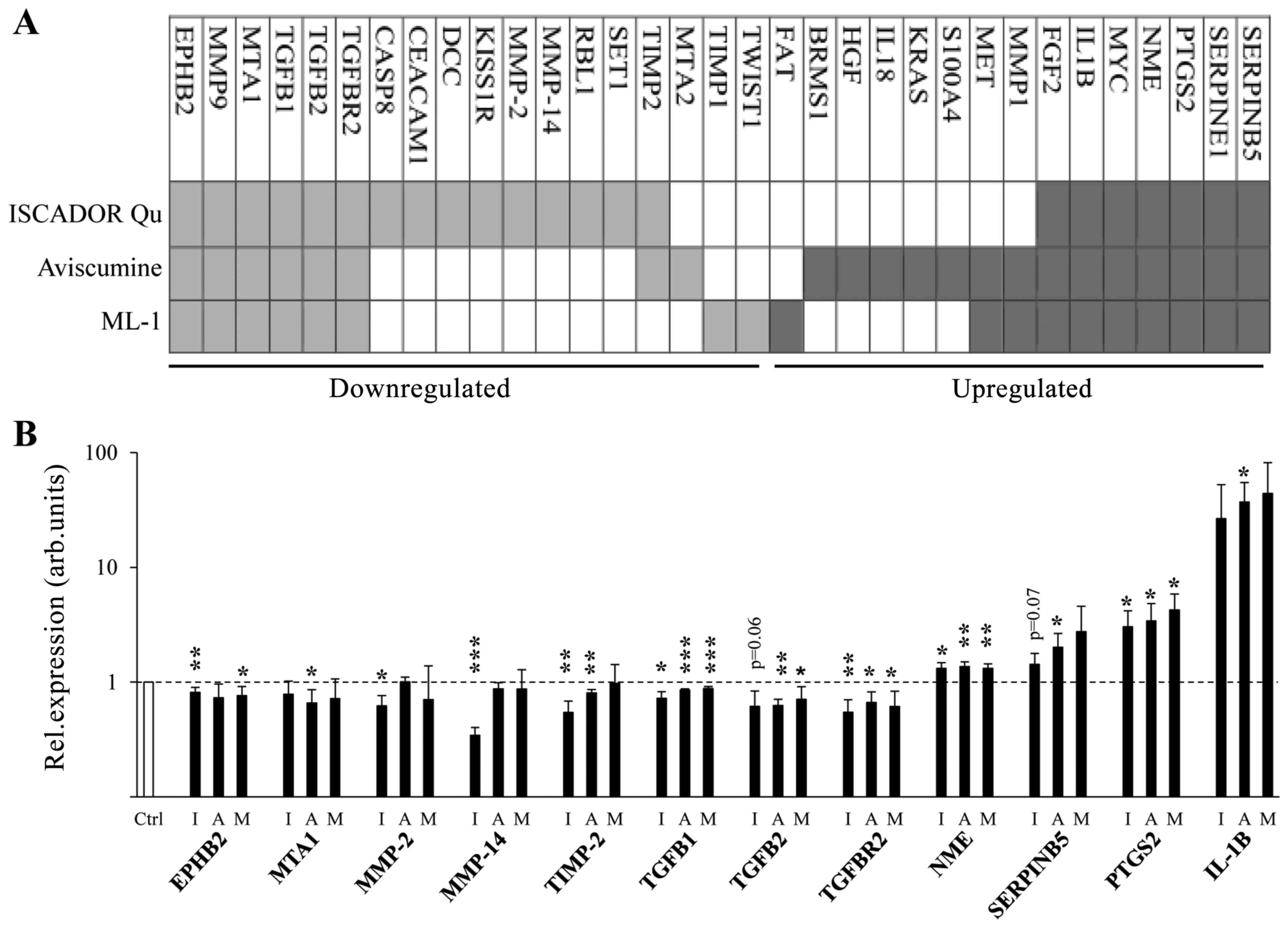 |
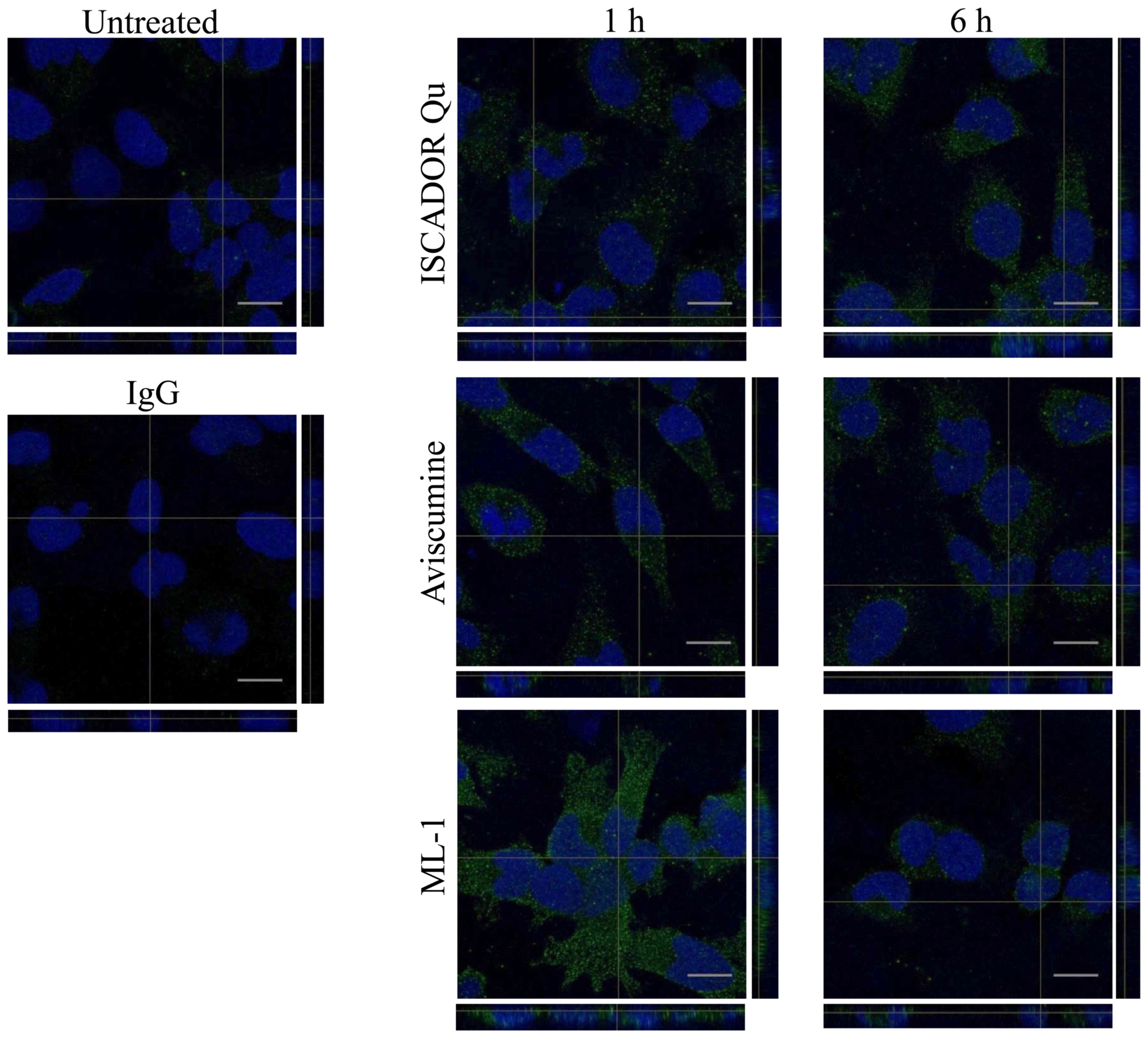 |
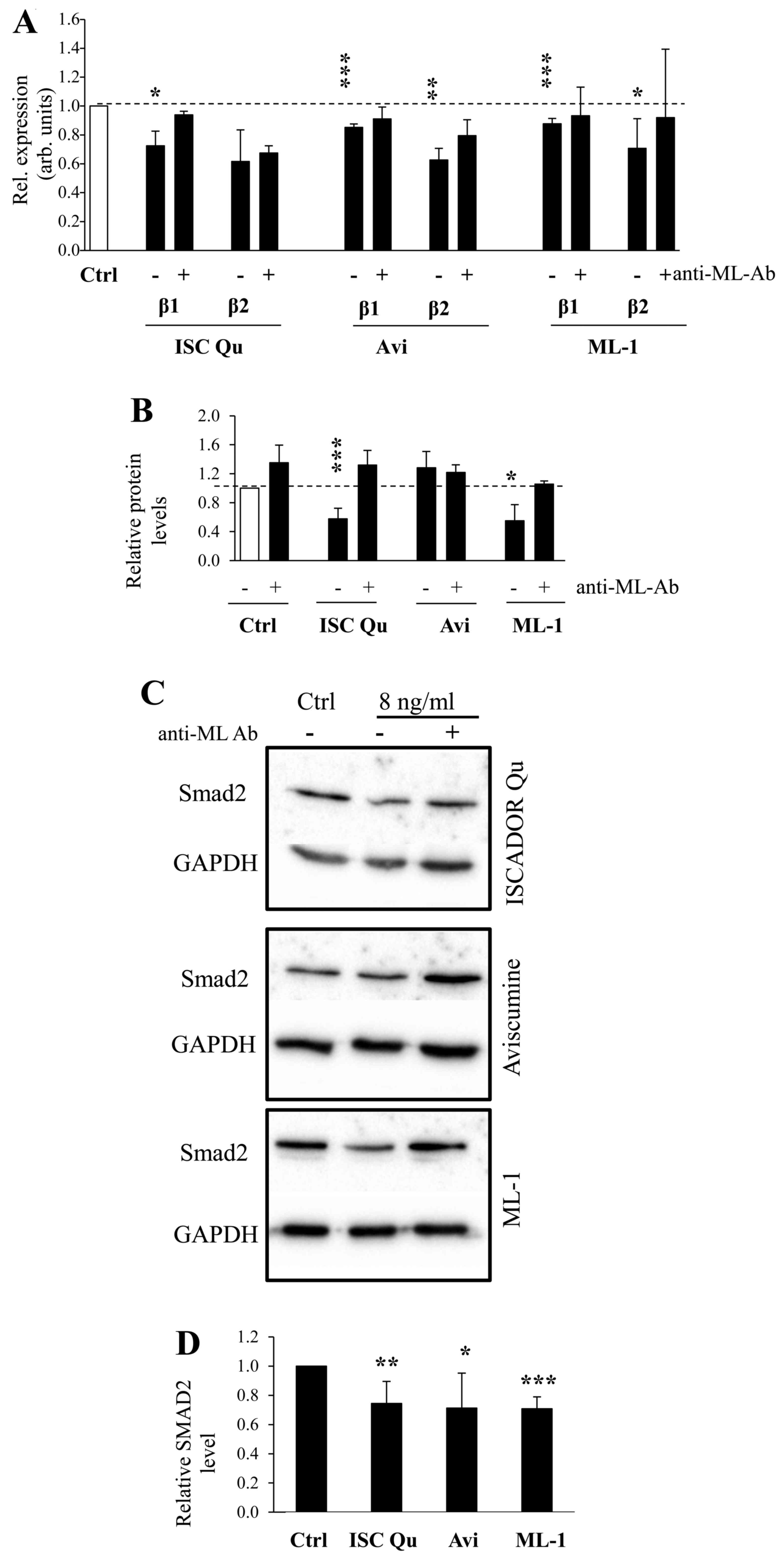 |
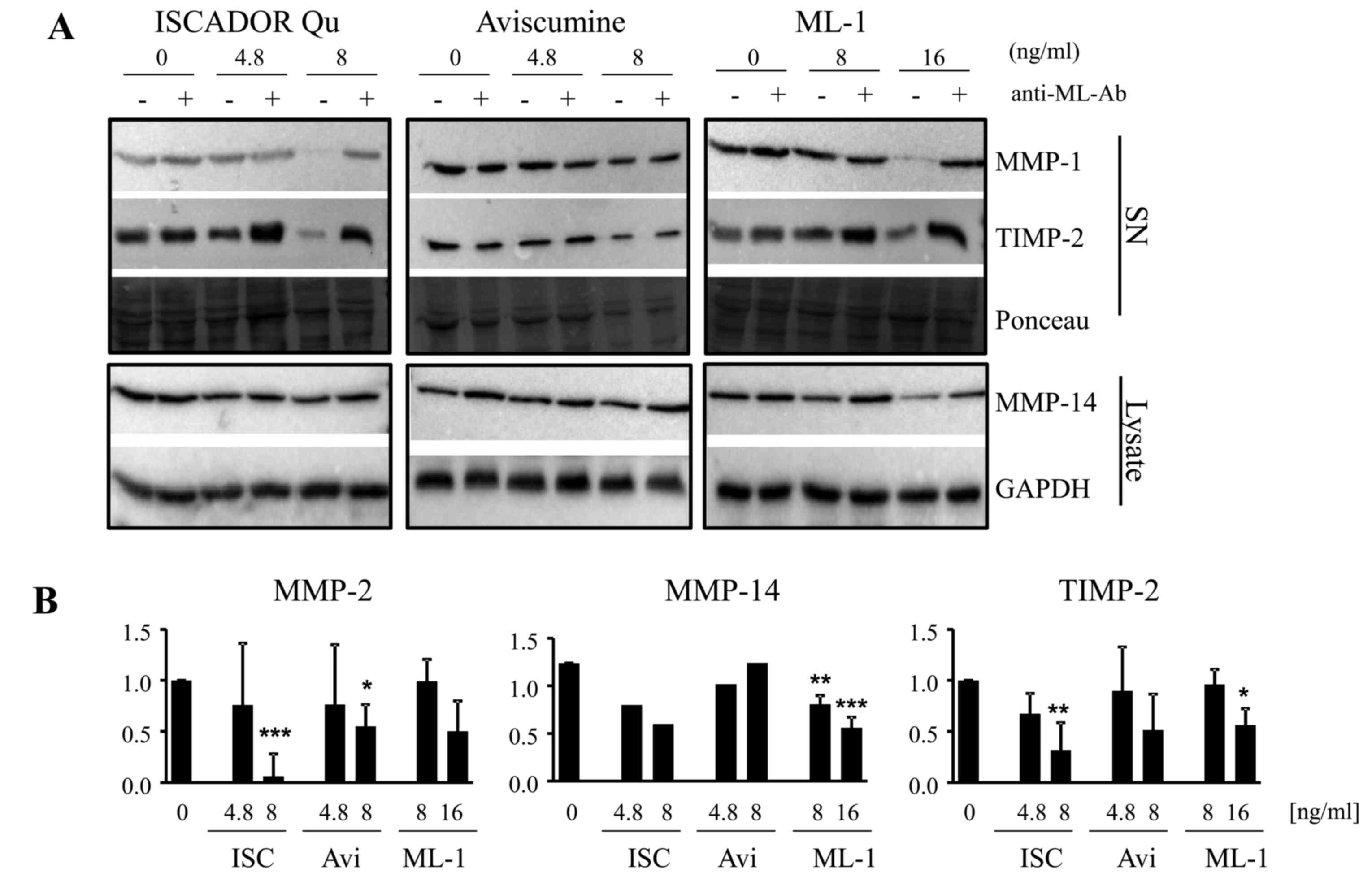 |
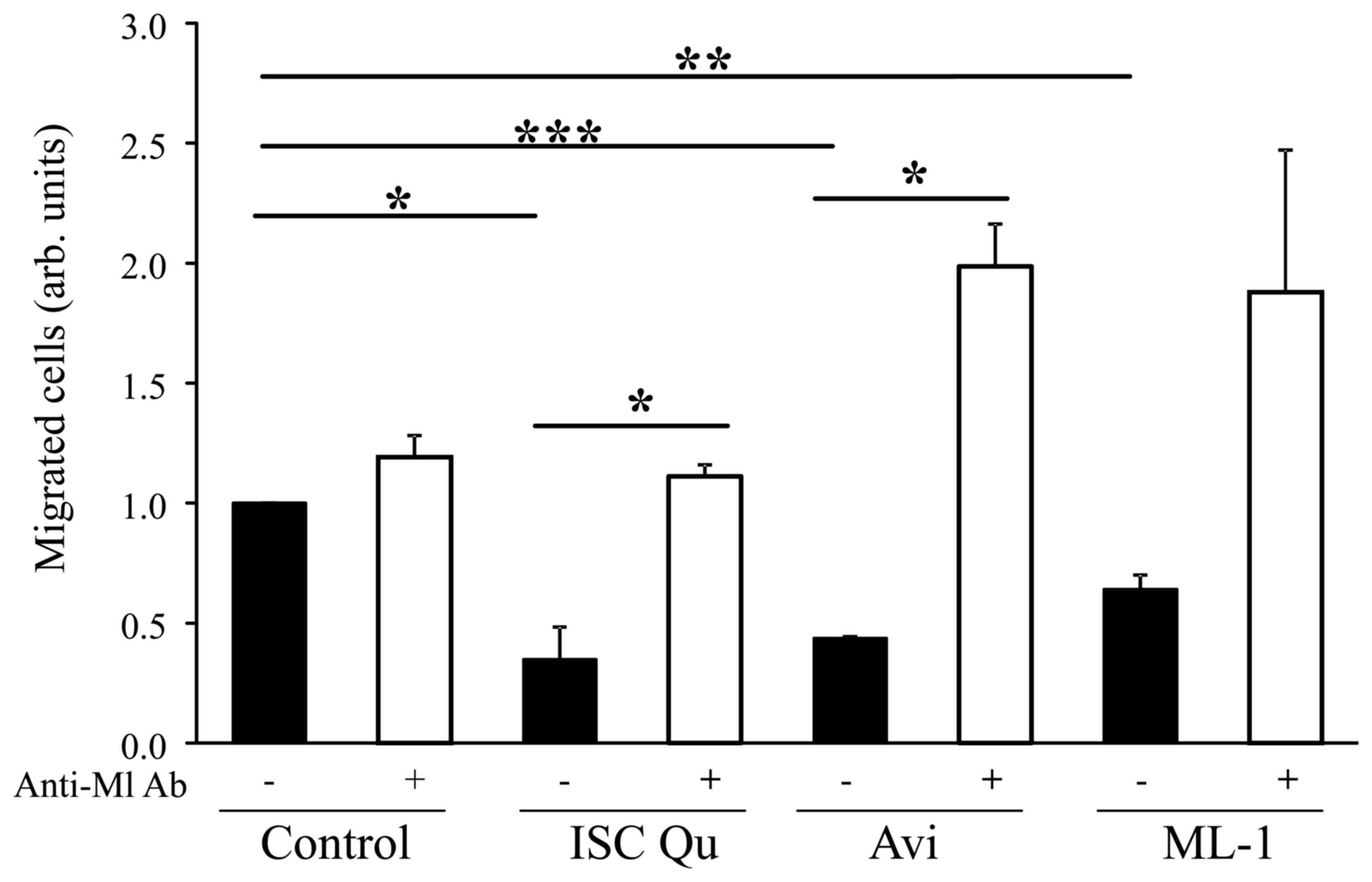 |
|
Stupp R, Mason WP, van den Bent MJ, Weller M, Fisher B, Taphoorn MJ, Belanger K, Brandes AA, Marosi C, Bogdahn U, et al European Organisation for Research and Treatment of Cancer Brain Tumor and Radiotherapy Groups; National Cancer Institute of Canada Clinical Trials Group: Radiotherapy plus concomitant and adjuvant temozolomide for glioblastoma. N Engl J Med. 352:987–996. 2005. View Article : Google Scholar : PubMed/NCBI | |
|
Claes A, Idema AJ and Wesseling P: Diffuse glioma growth: A guerilla war. Acta Neuropathol. 114:443–458. 2007. View Article : Google Scholar : PubMed/NCBI | |
|
Wick W, Platten M and Weller M: Glioma cell invasion: Regulation of metalloproteinase activity by TGF-beta. J Neurooncol. 53:177–185. 2001. View Article : Google Scholar : PubMed/NCBI | |
|
Wild-Bode C, Weller M and Wick W: Molecular determinants of glioma cell migration and invasion. J Neurosurg. 94:978–984. 2001. View Article : Google Scholar : PubMed/NCBI | |
|
Wick W, Naumann U and Weller M: Transforming growth factor-beta: A molecular target for the future therapy of glioblastoma. Curr Pharm Des. 12:341–349. 2006. View Article : Google Scholar : PubMed/NCBI | |
|
Kahlert UD, Nikkhah G and Maciaczyk J: Epithelial-to-mesenchymal(-like) transition as a relevant molecular event in malignant gliomas. Cancer Lett. 331:131–138. 2013. View Article : Google Scholar | |
|
Naumann U, Harter PN, Rubel J, Ilina E, Blank AE, Esteban H and Mittelbronn M: Glioma cell migration and invasion as potential target for novel treatment strategies. Transl Neurosci. 4:314–329. 2013. View Article : Google Scholar | |
|
Kathagen A, Schulte A, Balcke G, Phillips HS, Martens T, Matschke J, Günther HS, Soriano R, Modrusan Z, Sandmann T, et al: Hypoxia and oxygenation induce a metabolic switch between pentose phosphate pathway and glycolysis in glioma stem-like cells. Acta Neuropathol. 126:763–780. 2013. View Article : Google Scholar : PubMed/NCBI | |
|
Mistletoe Extracts :(PDQ®): Health Professional Version. PDQ Cancer Information Summaries (Internet) Bethesda (MD): 2016, Available from: https://www.ncbi.nlm.nih.gov/books/NBK66054/. | |
|
Yau T, Dan X, Ng CC and Ng TB: Lectins with potential for anti-cancer therapy. Molecules. 20:3791–3810. 2015. View Article : Google Scholar : PubMed/NCBI | |
|
Elluru S, Duong Van Huyen JP, Delignat S, Prost F, Bayry J, Kazatchkine MD and Kaveri SV: Molecular mechanisms underlying the immunomodulatory effects of mistletoe (Viscum album L.) extracts Iscador. Arzneimittelforschung. 56(6A): 461–466. 2006.PubMed/NCBI | |
|
Büssing A and Schietzel M: Apoptosis-inducing properties of Viscum album L. extracts from different host trees, correlate with their content of toxic mistletoe lectins. Anticancer Res. 19(1A): 23–28. 1999.PubMed/NCBI | |
|
Pryme IF, Bardocz S, Pusztai A and Ewen SW: Suppression of growth of tumour cell lines in vitro and tumours in vivo by mistletoe lectins. Histol Histopathol. 21:285–299. 2006. | |
|
Hajtó T, Fodor K, Perjési P and Németh P: Difficulties and perspectives of immunomodulatory therapy with mistletoe lectins and standardized mistletoe extracts in evidence-based medicine. Evid Based Complement Alternat Med. 2011:2989722011. View Article : Google Scholar : | |
|
Podlech O, Harter PN, Mittelbronn M, Pöschel S and Naumann U: Fermented mistletoe extract as a multimodal antitumoral agent in gliomas. Evid Based Complement Alternat Med. 2012:5017962012. View Article : Google Scholar : PubMed/NCBI | |
|
Schöffski P, Riggert S, Fumoleau P, Campone M, Bolte O, Marreaud S, Lacombe D, Baron B, Herold M, Zwierzina H, et al European Organization for Research and Treatment of Cancer New Drug Development Group: Phase I trial of intravenous aviscumine (rViscumin) in patients with solid tumors: A study of the European Organization for Research and Treatment of Cancer New Drug Development Group. Ann Oncol. 15:1816–1824. 2004. View Article : Google Scholar : PubMed/NCBI | |
|
Urech K, Schaller G and Jäggy C: Viscotoxins, mistletoe lectins and their isoforms in mistletoe (Viscum album L.) extracts Iscador. Arzneimittelforschung. 56(6A): 428–434. 2006.PubMed/NCBI | |
|
Jung ML, Baudino S, Ribéreau-Gayon G and Beck JP: Characterization of cytotoxic proteins from mistletoe (Viscum album L.). Cancer Lett. 51:103–108. 1990. View Article : Google Scholar : PubMed/NCBI | |
|
Eck J, Langer M, Möckel B, Witthohn K, Zinke H and Lentzen H: Characterization of recombinant and plant-derived mistletoe lectin and their B-chains. Eur J Biochem. 265:788–797. 1999. View Article : Google Scholar : PubMed/NCBI | |
|
Eck J, Langer M, Möckel B, Baur A, Rothe M, Zinke H and Lentzen H: Cloning of the mistletoe lectin gene and characterization of the recombinant A-chain. Eur J Biochem. 264:775–784. 1999. View Article : Google Scholar : PubMed/NCBI | |
|
Zwierzina H, Bergmann L, Fiebig H, Aamdal S, Schöffski P, Witthohn K and Lentzen H: The preclinical and clinical activity of aviscumine: A potential anticancer drug. Eur J Cancer. 47:1450–1457. 2011. View Article : Google Scholar : PubMed/NCBI | |
|
Naumann U, Kügler S, Wolburg H, Wick W, Rascher G, Schulz JB, Conseiller E, Bähr M and Weller M: Chimeric tumor suppressor 1, a p53-derived chimeric tumor suppressor gene, kills p53 mutant and p53 wild-type glioma cells in synergy with irradiation and CD95 ligand. Cancer Res. 61:5833–5842. 2001.PubMed/NCBI | |
|
Platten M, Wick W and Weller M: Malignant glioma biology: Role for TGF-beta in growth, motility, angiogenesis, and immune escape. Microsc Res Tech. 52:401–410. 2001. View Article : Google Scholar : PubMed/NCBI | |
|
Nakano A, Tani E, Miyazaki K, Yamamoto Y and Furuyama J: Matrix metalloproteinases and tissue inhibitors of metalloproteinases in human gliomas. J Neurosurg. 83:298–307. 1995. View Article : Google Scholar : PubMed/NCBI | |
|
Nikolai G, Friedl P, Werner M, Niggemann B and Zänker KS: Effect of a mistletoe extract (Iscador QuFrF) on viability and migratory behavior of human peripheral CD4+ and CD8+ T lymphocytes in three-dimensional collagen lattices. In Vitro Cell Dev Biol Anim. 33:710–716. 1997. View Article : Google Scholar : PubMed/NCBI | |
|
Gren A: Effects of Iscador preparations on the reactivity of mouse immune system. Neuro Endocrinol Lett. 30:530–534. 2009.PubMed/NCBI | |
|
Kuttan G and Kuttan R: Immunological mechanism of action of the tumor reducing peptide from mistletoe extract (NSC 635089) cellular proliferation. Cancer Lett. 66:123–130. 1992. View Article : Google Scholar : PubMed/NCBI | |
|
Braedel-Ruoff S: Immunomodulatory effects of Viscum album extracts on natural killer cells: Review of clinical trials. Forsch Komplement Med. 17:63–73. 2010. View Article : Google Scholar | |
|
Schink M, Tröger W, Dabidian A, Goyert A, Scheuerecker H, Meyer J, Fischer IU and Glaser F: Mistletoe extract reduces the surgical suppression of natural killer cell activity in cancer patients. a randomized phase III trial. Forsch Komplement Med. 14:9–17. 2007. View Article : Google Scholar | |
|
Antony S, Kuttan R and Kuttan G: Role of natural killer cells in iscador mediated inhibition of metastasis by adoptive immunotherapy. Immunol Invest. 29:219–231. 2000. View Article : Google Scholar : PubMed/NCBI | |
|
Thies A, Dautel P, Meyer A, Pfüller U and Schumacher U: Low-dose mistletoe lectin-I reduces melanoma growth and spread in a scid mouse xenograft model. Br J Cancer. 98:106–112. 2008. View Article : Google Scholar | |
|
Tröger W, Galun D, Reif M, Schumann A, Stanković N and Milićević M: Viscum album [L.] extract therapy in patients with locally advanced or metastatic pancreatic cancer: A randomised clinical trial on overall survival. Eur J Cancer. 49:3788–3797. 2013. View Article : Google Scholar | |
|
Büssing A, Raak C and Ostermann T: Quality of life and related dimensions in cancer patients treated with mistletoe extract (iscador): A meta-analysis. Evid Based Complement Alternat Med. 2012:2194022012. View Article : Google Scholar | |
|
Ostermann T, Raak C and Büssing A: Survival of cancer patients treated with mistletoe extract (Iscador): A systematic literature review. BMC Cancer. 9:4512009. View Article : Google Scholar : PubMed/NCBI | |
|
Trefzer U, Gutzmer R, Wilhelm T, Schenck F, Kähler KC, Jacobi V, Witthohn K, Lentzen H and Mohr P: Treatment of unresectable stage IV metastatic melanoma with aviscumine after anti-neoplastic treatment failure: A phase II, multi-centre study. J Immunother Cancer. 2:272014. View Article : Google Scholar : PubMed/NCBI | |
|
Naumann U, Maass P, Gleske AK, Aulwurm S, Weller M and Eisele G: Glioma gene therapy with soluble transforming growth factor-beta receptors II and III. Int J Oncol. 33:759–765. 2008.PubMed/NCBI | |
|
Nakada M, Niska JA, Miyamori H, McDonough WS, Wu J, Sato H and Berens ME: The phosphorylation of EphB2 receptor regulates migration and invasion of human glioma cells. Cancer Res. 64:3179–3185. 2004. View Article : Google Scholar : PubMed/NCBI | |
|
Wang SD, Rath P, Lal B, Richard JP, Li Y, Goodwin CR, Laterra J and Xia S: EphB2 receptor controls proliferation/migration dichotomy of glioblastoma by interacting with focal adhesion kinase. Oncogene. 31:5132–5143. 2012. View Article : Google Scholar : PubMed/NCBI | |
|
Huang Q, Zhang QB, Dong J, Wu YY, Shen YT, Zhao YD, Zhu YD, Diao Y, Wang AD and Lan Q: Glioma stem cells are more aggressive in recurrent tumors with malignant progression than in the primary tumor, and both can be maintained long-term in vitro. BMC Cancer. 8:3042008. View Article : Google Scholar : PubMed/NCBI | |
|
Zhang W, Men X and Lei P: Review on anti-tumor effect of triterpene acid compounds. J Cancer Res Ther. 10(Suppl 1): 14–19. 2014. View Article : Google Scholar : PubMed/NCBI | |
|
Kandaswami C, Lee LT, Lee PP, Hwang JJ, Ke FC, Huang YT and Lee MT: The antitumor activities of flavonoids. In Vivo. 19:895–909. 2005.PubMed/NCBI | |
|
Gdynia G, Grund K, Eckert A, Böck BC, Funke B, Macher-Goeppinger S, Sieber S, Herold-Mende C, Wiestler B, Wiestler OD, et al: Basal caspase activity promotes migration and invasiveness in glioblastoma cells. Mol Cancer Res. 5:1232–1240. 2007. View Article : Google Scholar | |
|
Liu W, Wei W, Winer D, Bamberger AM, Bamberger C, Wagener C, Ezzat S and Asa SL: CEACAM1 impedes thyroid cancer growth but promotes invasiveness: A putative mechanism for early metastases. Oncogene. 26:2747–2758. 2007. View Article : Google Scholar | |
|
Ebrahimnejad A, Streichert T, Nollau P, Horst AK, Wagener C, Bamberger AM and Brümmer J: CEACAM1 enhances invasion and migration of melanocytic and melanoma cells. Am J Pathol. 165:1781–1787. 2004. View Article : Google Scholar : PubMed/NCBI | |
|
Shekarabi M and Kennedy TE: The netrin-1 receptor DCC promotes filopodia formation and cell spreading by activating Cdc42 and Rac1. Mol Cell Neurosci. 19:1–17. 2002. View Article : Google Scholar : PubMed/NCBI | |
|
Nakada M, Kita D, Futami K, Yamashita J, Fujimoto N, Sato H and Okada Y: Roles of membrane type 1 matrix metalloproteinase and tissue inhibitor of metalloproteinases 2 in invasion and dissemination of human malignant glioma. J Neurosurg. 94:464–473. 2001. View Article : Google Scholar : PubMed/NCBI | |
|
Lam BD, Anthony EC and Hordijk PL: Analysis of nucleocytoplasmic shuttling of the proto-oncogene SET/I2PP2A. Cytometry A. 81:81–89. 2012. | |
|
Goertzen CG, Dragan M, Turley E, Babwah AV and Bhattacharya M: KISS1R signaling promotes invadopodia formation in human breast cancer cell via β-arrestin2/ERK. Cell Signal. 28:165–176. 2016. View Article : Google Scholar : PubMed/NCBI | |
|
Wu F, Li JQ, Miki H, Nishioka M, Fujita J, Ohmori M, Imaida K and Kuriyama S: p107 Expression in colorectal tumours rises during carcinogenesis and falls during invasion. Eur J Cancer. 38:1838–1848. 2002. View Article : Google Scholar : PubMed/NCBI | |
|
Mei P, Bai J, Shi M, Liu Q, Li Z, Fan Y and Zheng J: BRMS1 suppresses glioma progression by regulating invasion, migration and adhesion of glioma cells. PLoS One. 9:e985442014. View Article : Google Scholar : PubMed/NCBI | |
|
Sooman L, Freyhult E, Jaiswal A, Navani S, Edqvist PH, Pontén F, Tchougounova E, Smits A, Elsir T, Gullbo J, et al: FGF2 as a potential prognostic biomarker for proneural glioma patients. Acta Oncol. 54:385–394. 2015. View Article : Google Scholar | |
|
Chen D, Persson A, Sun Y, Salford LG, Nord DG, Englund E, Jiang T and Fan X: Better prognosis of patients with glioma expressing FGF2-dependent PDGFRA irrespective of morphological diagnosis. PLoS One. 8:e615562013. View Article : Google Scholar : PubMed/NCBI | |
|
Boissan M, Poupon MF and Lacombe ML: NM23 and metastasis suppressor genes: Update. Med Sci (Paris). 23:1115–1123. 2007.In French. View Article : Google Scholar | |
|
McDermott WG, Boissan M, Lacombe ML, Steeg PS and Horak CE: Nm23-H1 homologs suppress tumor cell motility and anchorage independent growth. Clin Exp Metastasis. 25:131–138. 2008. View Article : Google Scholar | |
|
Chou RH, Wen HC, Liang WG, Lin SC, Yuan HW, Wu CW and Chang WS: Suppression of the invasion and migration of cancer cells by SERPINB family genes and their derived peptides. Oncol Rep. 27:238–245. 2012. | |
|
Xu L, Liu H, Yu J, Wang Z, Zhu Q, Li Z, Zhong Q, Zhang S, Qu M and Lan Q: Methylation-induced silencing of maspin contributes to the proliferation of human glioma cells. Oncol Rep. 36:57–64. 2016.PubMed/NCBI | |
|
Lam S, Wiercinska E, Teunisse AF, Lodder K, ten Dijke P and Jochemsen AG: Wild-type p53 inhibits pro-invasive properties of TGF-β3 in breast cancer, in part through regulation of EPHB2, a new TGF-β target gene. Breast Cancer Res Treat. 148:7–18. 2014. View Article : Google Scholar : PubMed/NCBI | |
|
Wang M, Wang T, Liu S, Yoshida D and Teramoto A: The expression of matrix metalloproteinase-2 and -9 in human gliomas of different pathological grades. Brain Tumor Pathol. 20:65–72. 2003. View Article : Google Scholar | |
|
Wang L, Yuan J, Tu Y, Mao X, He S, Fu G, Zong J and Zhang Y: Co-expression of MMP-14 and MMP-19 predicts poor survival in human glioma. Clin Transl Oncol. 15:139–145. 2013. View Article : Google Scholar | |
|
Ulasov I, Yi R, Guo D, Sarvaiya P and Cobbs C: The emerging role of MMP14 in brain tumorigenesis and future therapeutics. Biochim Biophys Acta. 1846:113–120. 2014.PubMed/NCBI | |
|
Shastry AH, Thota B, Arimappamagan A and Santosh V: P53 stratification reveals the prognostic utility of matrix metalloproteinase-9 protein expression in glioblastoma. Neurol India. 63:399–404. 2015. View Article : Google Scholar : PubMed/NCBI | |
|
Asuthkar S, Velpula KK, Chetty C, Gorantla B and Rao JS: Epigenetic regulation of miRNA-211 by MMP-9 governs glioma cell apoptosis, chemosensitivity and radiosensitivity. Oncotarget. 3:1439–1454. 2012. View Article : Google Scholar : PubMed/NCBI | |
|
Hofer MD, Menke A, Genze F, Gierschik P and Giehl K: Expression of MTA1 promotes motility and invasiveness of PANC-1 pancreatic carcinoma cells. Br J Cancer. 90:455–462. 2004. View Article : Google Scholar : PubMed/NCBI | |
|
Cheng CY, Chou YE, Ko CP, Yang SF, Hsieh SC, Lin CL, Hsieh YH and Chen KC: Metastasis tumor-associated protein-2 knockdown suppresses the proliferation and invasion of human glioma cells in vitro and in vivo. J Neurooncol. 120:273–281. 2014. View Article : Google Scholar : PubMed/NCBI | |
|
ten Klooster JP, Leeuwen I, Scheres N, Anthony EC and Hordijk PL: Rac1-induced cell migration requires membrane recruitment of the nuclear oncogene SET. EMBO J. 26:336–345. 2007. View Article : Google Scholar : PubMed/NCBI | |
|
Li J, Yang XF, Ren XH, Meng XJ, Huang HY, Zhao QH, Yuan JH, Hong WX, Xia B, Huang XF, et al: Stable SET knockdown in breast cell carcinoma inhibits cell migration and invasion. Biochem Biophys Res Commun. 453:7–12. 2014. View Article : Google Scholar : PubMed/NCBI | |
|
Gomez DE, Alonso DF, Yoshiji H and Thorgeirsson UP: Tissue inhibitors of metalloproteinases: Structure, regulation and biological functions. Eur J Cell Biol. 74:111–122. 1997.PubMed/NCBI | |
|
Lu KV, Jong KA, Rajasekaran AK, Cloughesy TF and Mischel PS: Upregulation of tissue inhibitor of metalloproteinases (TIMP)-2 promotes matrix metalloproteinase (MMP)-2 activation and cell invasion in a human glioblastoma cell line. Lab Invest. 84:8–20. 2004. View Article : Google Scholar | |
|
Mikheeva SA, Mikheev AM, Petit A, Beyer R, Oxford RG, Khorasani L, Maxwell JP, Glackin CA, Wakimoto H, González-Herrero I, et al: TWIST1 promotes invasion through mesenchymal change in human glioblastoma. Mol Cancer. 9:1942010. View Article : Google Scholar : PubMed/NCBI | |
|
Elias MC, Tozer KR, Silber JR, Mikheeva S, Deng M, Morrison RS, Manning TC, Silbergeld DL, Glackin CA, Reh TA, et al: TWIST is expressed in human gliomas and promotes invasion. Neoplasia. 7:824–837. 2005. View Article : Google Scholar : PubMed/NCBI | |
|
Madan E, Dikshit B, Gowda SH, Srivastava C, Sarkar C, Chattopadhyay P, Sinha S and Chosdol K: FAT1 is a novel upstream regulator of HIF1α and invasion of high grade glioma. Int J Cancer. 139:2570–2582. 2016. View Article : Google Scholar : PubMed/NCBI | |
|
Lu KV, Chang JP, Parachoniak CA, Pandika MM, Aghi MK, Meyronet D, Isachenko N, Fouse SD, Phillips JJ, Cheresh DA, et al: VEGF inhibits tumor cell invasion and mesenchymal transition through a MET/VEGFR2 complex. Cancer Cell. 22:21–35. 2012. View Article : Google Scholar : PubMed/NCBI | |
|
Kast RE: The role of interleukin-18 in glioblastoma pathology implies therapeutic potential of two old drugs-disulfiram and ritonavir. Chin J Cancer. 34:161–165. 2015. View Article : Google Scholar : PubMed/NCBI | |
|
Fathima Hurmath K, Ramaswamy P and Nandakumar DN: IL-1β microenvironment promotes proliferation, migration, and invasion of human glioma cells. Cell Biol Int. 38:1415–1422. 2014. View Article : Google Scholar : PubMed/NCBI | |
|
Lyu SY and Park WB: Effects of Korean mistletoe lectin (Viscum album coloratum) on proliferation and cytokine expression in human peripheral blood mononuclear cells and T-lymphocytes. Arch Pharm Res. 30:1252–1264. 2007. View Article : Google Scholar : PubMed/NCBI | |
|
Sunaga N, Imai H, Shimizu K, Shames DS, Kakegawa S, Girard L, Sato M, Kaira K, Ishizuka T, Gazdar AF, et al: Oncogenic KRAS-induced interleukin-8 overexpression promotes cell growth and migration and contributes to aggressive phenotypes of non-small cell lung cancer. Int J Cancer. 130:1733–1744. 2012. View Article : Google Scholar : | |
|
Pullen NA, Anand M, Cooper PS and Fillmore HL: Matrix metalloproteinase-1 expression enhances tumorigenicity as well as tumor-related angiogenesis and is inversely associated with TIMP-4 expression in a model of glioblastoma. J Neurooncol. 106:461–471. 2012. View Article : Google Scholar | |
|
Anand M, Van Meter TE and Fillmore HL: Epidermal growth factor induces matrix metalloproteinase-1 (MMP-1) expression and invasion in glioma cell lines via the MAPK pathway. J Neurooncol. 104:679–687. 2011. View Article : Google Scholar : PubMed/NCBI | |
|
Dhruv HD, McDonough Winslow WS, Armstrong B, Tuncali S, Eschbacher J, Kislin K, Loftus JC, Tran NL and Berens ME: Reciprocal activation of transcription factors underlies the dichotomy between proliferation and invasion of glioma cells. PLoS One. 8:e721342013. View Article : Google Scholar : PubMed/NCBI | |
|
Jung S, Paek YW, Moon KS, Wee SC, Ryu HH, Jeong YI, Sun HS, Jin YH, Kim KK and Ahn KY: Expression of Nm23 in gliomas and its effect on migration and invasion in vitro. Anticancer Res. 26:249–258. 2006.PubMed/NCBI | |
|
Xu K, Wang L and Shu HK: COX-2 overexpression increases malignant potential of human glioma cells through Id1. Oncotarget. 5:1241–1252. 2014. View Article : Google Scholar : PubMed/NCBI | |
|
Belot N, Pochet R, Heizmann CW, Kiss R and Decaestecker C: Extracellular S100A4 stimulates the migration rate of astrocytic tumor cells by modifying the organization of their actin cytoskeleton. Biochim Biophys Acta. 1600:74–83. 2002. View Article : Google Scholar : PubMed/NCBI | |
|
Klein RM, Bernstein D, Higgins SP, Higgins CE and Higgins PJ: SERPINE1 expression discriminates site-specific metastasis in human melanoma. Exp Dermatol. 21:551–554. 2012. View Article : Google Scholar : PubMed/NCBI |









